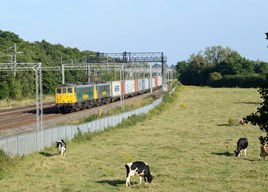Switching from diesel to electric traction will have more effect on freight train speeds than simply increasing speed limits from 75mph to 90mph, according to Network Rail in its draft Freight Network Study.
Average speeds of freight trains remain low, with those northbound through Crewe running at just 25mph, and those between Immingham and Drax (a journey which would take a lorry around an hour) just 17mph.
Network Rail sampled the two routes in November and December 2015. It found that the minimum and maximum average speeds on the section between Norton Bridge and Winsford were 7mph and 73mph, and from Immingham Biomass Loading Point to Drax 9mph and 26mph.
- For more on this, read RAIL 808, published on August 31.














Login to comment
Comments
BigTone - 30/08/2016 18:33
I cannot see how electrification can improve freight journeys in these examples. Most is down to the trackwork
Andrewjgwilt1989 - 30/08/2016 22:07
Is there any by chance that the freight route between Felixstowe and Nuneaton could be electrified with the Felixstowe to be electrified and possibly other rural lines in East Anglia that could also be electrified even though new hybrid trains are to be ordered as Abellio Greater Anglia/Abellio East Anglia are to order new EMU trains and Bi-Mode trains in the upcoming years.
FrankH - 31/08/2016 23:49
Timetabling is the issue, 2 prime examples I've had my eye on for ages. This shows what is possible and what actually happens.The 06.07 mossend - daventry, loads to 1650 ton hauled by 2 class 90's.( Used to be a class 92) Timetable pass time at preston 11.32. 05.30 Coatbridge FLT - Daventry scheduled at mossend nth jnct 0559 13 minutes in front of the other passes Preston 09.12. this is hauled by a class 70. This train gets looped once at Carlisle Kingmoor for 6 minutes. The class 90 train is like taking a dog for a walk, it stops at every lampost (loop) nearly. It looses 2hours on a train it followed out of Mossend yard on the run to Preston. Maybe it's because the 70 is a co-co and a heavy loco with more adhesion than the light bo-bo 90's. The 92's can handle the freight and at speed but DB cargo reckons they're 4 times more expensive to run than a 90. I just hope DRS doesn't regret the 88's being bo-bo's instead of co-co with a bit more weight.
FrankH - 06/09/2016 03:40
A correction, a 92's operating costs are more than a pair of 90's.
BigTone - 15/09/2016 13:00
DRS said that Class 88 can match Class 92. Like you and for the reasons you gave, I cannot see it. Also the Class 92 has the traction control of the Class 60
FrankH - 06/09/2016 21:26
Any major change to electric traction will need new locos. The class 92's are the only available option and there are non spare. What are serviceable are equipped for channel tunnel use maybe 7. The other good examples have been exported to Romania/Bulgaria for use on DB cargo work there (I think). GBRF has some, how many operational I don't know. it's having enough issues getting them ready for Scotrail sleeper use.
BigTone - 15/09/2016 12:55
I think the problem with the Class 92 is / was that most were just parked up instead of getting use so problems were not being found and sorted
FrankH - 15/09/2016 23:55
It was only 20 years ago they first used. As you say parked up because of insufficient tunnel traffic, also the fact they're expensive to run. There were enough electric locos back then to cope but wholesale withdrawing and scrapping class 86 and 87's perfectly capable for freight use after re gearing has left hauliers with nothing but class 66's and 70's. Also the fact that until more terminals have OHL at least to the gate no one DRS excepted will buy new electric/bi mode locos. I expect operators to be watching DRS 88's performance closely. They'll have to be able to work WCML freight single handed and with capacity to spare to be deemed a success. Myself i think they're to light to cope with the northern hills. Just seen your reply above re 88 vs 92. A 92 is 126 ton with 360 - 400 kn or 81 - 91 000 lbs tractive effort and 6760 hp. Class 88 is 86 ton with 317 kn or 71000 lbs tractive effort with 5400 hp, the class 68's are near identical at 3800 hp. Not in this world can they match a 92 with 40 ton less loco weight and 1360 hp less.